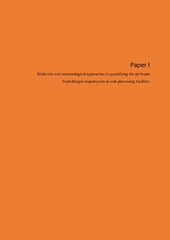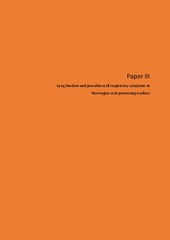| dc.contributor.advisor | Aasmoe, Lisbeth | |
| dc.contributor.author | Thomassen, Marte Renate | |
| dc.date.accessioned | 2017-11-14T17:54:52Z | |
| dc.date.available | 2017-11-14T17:54:52Z | |
| dc.date.issued | 2017-11-10 | |
| dc.description.abstract | Occupational asthma and allergy are health problems found in the seafood processing industry. The aim of this thesis was to investigate the exposure to central components in bioaerosols collected in the breathing zone of crab processing workers, and explore the workers’ prevalence of respiratory symptoms and sensitisation to crustacean allergens.
This thesis describes the exposure levels of total protein, tropomyosin, trypsin, NAGase and endotoxin in king crab and edible crab processing plants. This work establishes that both king crab and edible crab processing workers are exposed to bioaerosols containing these components. When comparing king crab and edible crab processing, king crab processing results in highest levels of endotoxin while edible crab processing has the highest levels of tropomyosin and total protein. Differences in exposure levels between the king crab processing plants suggesting a plant effect where local differences in production, ventilation and plant layout is important for the exposure to bioaerosols.
This work also describes the increased prevalence of respiratory symptoms among crab processing workers compared to a non-exposed control group. However, there is little difference between exposed workers and controls in lung function parameters. The control group has an increased prevalence of self-reported asthma and allergy compared to the crab processing workers.
Furthermore, this work demonstrates elevated IgE and positive skin prick test results among both king crab and edible crab workers. Immunoblots also show that workers are sensitised to several allergens, including tropomyosin, arginine kinase, enolase and hemocyanin.
The low prevalence of asthma and allergy despite the presence of respiratory symptoms and sensitisation suggests a healthy worker effect where unhealthy individuals are excluded from the workforce. It causes an underestimation of the health effects of working in the plant. | en_US |
| dc.description.doctoraltype | ph.d. | en_US |
| dc.description.popularabstract | Workers processing seafood can develop occupational health problems. This work examined the biological exposure in crab processing workers as well as respiratory health and sensitisation to the crab. Workers are exposed to proteins, allergens, enzymes and endotoxin in the air they breathe. Exposure levels differ between work tasks and between the plants. Workers reported respiratory symptoms, and several were sensitised to different parts of the crab. This suggests processing workers develop health problems and are at risk of developing allergy or asthma. But the crab processing workers reported less asthma and allergy than non-exposed controls. This suggests a healthy worker effect, where workers developing health problems leave the processing plants and cause an underestimation of health effects of crab processing. Better methods for monitoring occupational allergy and proper training of workers and medical staff is needed to prevent asthma and allergy among crab processing workers. | en_US |
| dc.description.sponsorship | Norges astma og allergiforbund gjennom Extra-midler | en_US |
| dc.description | The papers II and IV of this thesis are not available in Munin. <br>
<br>
Paper II: Thomassen, M. R., Kamath, S. D., Lopata, A. L., Madsen, A. M., Eduard, W., Bang, B. E., Aasmoe, L.: “Occupational Exposure to Bioaerosols in Norwegian Crab Processing Plants”. Available in <a href=http://dx.doi.org/10.1093/annhyg/mew030> Ann Occup Hyg 2016, 60(7):781-94. </a>
<br>
<br>
Paper IV: Thomassen, M. R., Kamath, S. D., Bang, B. E., Lopata, A. L., Aasmoe, L.: “Allergic sensitisation among Norwegian king crab (Paralithodes camtschaticus) and edible crab (Cancer pagurus) processing workers and identification of major allergenic proteins”. (Manuscript). | en_US |
| dc.identifier.uri | https://hdl.handle.net/10037/11742 | |
| dc.language.iso | eng | en_US |
| dc.publisher | UiT The Arctic University of Norway | en_US |
| dc.publisher | UiT Norges arktiske universitet | en_US |
| dc.relation.ispartofseries | ISM skriftserie; 185 | |
| dc.rights.accessRights | openAccess | en_US |
| dc.rights.holder | Copyright 2017 The Author(s) | |
| dc.rights.uri | https://creativecommons.org/licenses/by-nc-sa/3.0 | en_US |
| dc.rights | Attribution-NonCommercial-ShareAlike 3.0 Unported (CC BY-NC-SA 3.0) | en_US |
| dc.subject | VDP::Medisinske Fag: 700::Helsefag: 800::Yrkesmedisin: 809 | en_US |
| dc.subject | VDP::Medical disciplines: 700::Health sciences: 800::Occupational health: 809 | en_US |
| dc.title | Occupational exposure, respiratory health and sensitisation among crab processing workers.
A study among processors of king crab (Paralithodes camtschaticus) and edible crab (Cancer pagurus) in Norwegian land based crab processing plants. | en_US |
| dc.type | Doctoral thesis | en_US |
| dc.type | Doktorgradsavhandling | en_US |


 English
English norsk
norsk


